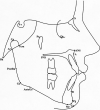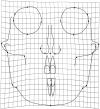Morphometric analysis of craniofacial features in mono- and dizygotic twins discordant for unilateral cleft lip and palate
- PMID: 21456957
- PMCID: PMC8916174
- DOI: 10.2319/121710-725.1
Morphometric analysis of craniofacial features in mono- and dizygotic twins discordant for unilateral cleft lip and palate
Abstract
Objective: To compare craniofacial differences between twins discordant for surgically repaired unilateral cleft lip and palate (CLP) during the developmental ages and to test the effect of zygosity on the shape and size of the craniofacial skeleton of the same twins by means of thin plate spline (TPS) analysis.
Materials and methods: Lateral and posteroanterior (PA) cephalometric films from 19 sets of monozygotic (MZ) twins (15 male and 4 female) and 10 dizygotic (DZ) twins (7 male and 3 female) were analyzed. TPS analysis evaluated statistically significant differences in the craniofacial shape and size between affected and unaffected twins within MZ and DZ twin couples.
Results: No statistically significant differences in craniofacial shape or size between CLP and non-CLP MZ or DZ twins were observed. The level of morphological similarity in CLP vs non-CLP MZ twins was statistically greater than in DZ twins.
Conclusions: Morphometric analysis showed that surgically repaired CLP does not produce significant shape or size differences in the craniofacial features of MZ or DZ twins discordant for unilateral CLP.
Figures





Similar articles
-
Exploration of genetic factors determining cleft side in a pair of monozygotic twins with mirror-image cleft lip and palate using whole-genome sequencing and comparison of craniofacial morphology.Arch Oral Biol. 2018 Dec;96:33-38. doi: 10.1016/j.archoralbio.2018.08.009. Epub 2018 Aug 19. Arch Oral Biol. 2018. PMID: 30172943
-
Etiological aspects on craniofacial morphology in twins with cleft lip and palate.Eur J Oral Sci. 1999 Apr;107(2):102-8. doi: 10.1046/j.0909-8836.1999.eos107205.x. Eur J Oral Sci. 1999. PMID: 10232458
-
Craniofacial morphology in twins with cleft lip and palate.Cleft Palate Craniofac J. 1996 Mar;33(2):96-103. doi: 10.1597/1545-1569_1996_033_0096_cmitwc_2.3.co_2. Cleft Palate Craniofac J. 1996. PMID: 8695628
-
Cleft-twin sets in Finland 1948-1987.Cleft Palate Craniofac J. 1996 Jul;33(4):340-7. doi: 10.1597/1545-1569_1996_033_0340_ctsif_2.3.co_2. Cleft Palate Craniofac J. 1996. PMID: 8827393 Review.
-
Monozygotic triplets: concordance and discordance for cleft lip and palate / twin research reviews: depression in mothers of multiples; depression in mothers and fathers of ART conceived multiples; epigenetic differences in monozygotic twins; congenital anomalies in surviving twins / headlines x two: twin Chefs; the world's largest twin registry; twin table tennis champions.Twin Res Hum Genet. 2009 Aug;12(4):403-6. doi: 10.1375/twin.12.4.403. Twin Res Hum Genet. 2009. PMID: 19653841 Review.
Cited by
-
Craniofacial Analysis May Indicate Co-Occurrence of Skeletal Malocclusions and Associated Risks in Development of Cleft Lip and Palate.J Dev Biol. 2020 Jan 28;8(1):2. doi: 10.3390/jdb8010002. J Dev Biol. 2020. PMID: 32012961 Free PMC article.
References
-
- Kramer F. J, Baethge C, Sinikovic B, Schliephake H. An analysis of quality of life in 130 families having small children with cleft lip/palate using the impact on family scale. Int J Oral Maxillofac Surg. 2007;36:1146–1152. - PubMed
-
- Mars M, Houston W. J. A preliminary study of facial growth and morphology in unoperated male unilateral cleft lip and palate subjects over 13 years of age. Cleft Palate J. 1990;27:7–10. - PubMed
-
- Ross R. B. The clinical implications of facial growth in cleft lip and palate. Cleft Palate J. 1970;7:37–47. - PubMed
-
- Liao Y. F, Mars M. Long-term effects of palate repair on craniofacial morphology in patients with unilateral cleft lip and palate. Cleft Palate Craniofac J. 2005;42:594–600. - PubMed
Publication types
MeSH terms
LinkOut - more resources
Full Text Sources
Medical
Miscellaneous

